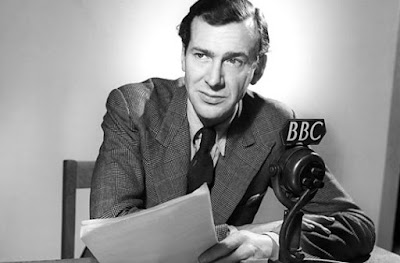A GHOST STORY FOR CHRISTMAS - THE DEAD ROOM (2018)
Dyall M for Murder: English character actor Valentine Dyall's sepulchral voice effortlessly graced radio drama. But he also had a fascinating acting and voice artist career on screen, with film roles as diverse as Jethro Keane in CITY OF THE DEAD and a finance minister in COME PLAY WITH ME. On television, Dyall appeared as The Black Guardian on DOCTOR WHO, and provided the vocalisation of Deep Thought in THE HITCHHIKER'S GUIDE TO THE GALAXY.
DUBBED "The British Vincent Price", Valentine Dyall's distinctive tone made him perfect as raconteur The Man in Black, who introduced the BBC radio series Appointment with Fear. Revived on a number of occasions since its inception in 1943, these dramatised half-hour horror stories drew on both classic tales of terror and original commissioned pieces; between 2009 and 2011, BBC Radio 4 Extra broadcast four series under the banner The Man in Black, with Mark Gatiss in the title role. Five years since the previous BBC A GHOST STORY FOR CHRISTMAS - the Gatiss adaptation and direction of M.R. James' The Tractate Middoth - Gatiss returns to pen and helm an original tale, THE DEAD ROOM, which fuses his love of these two great homegrown brands and rubbishes their heritage in one tidy half-hour.
THE DEAD ROOM refers to a long-running audio horror series presented by veteran luvvie Aubrey Judd (perfectly cast Simon Callow), a broadcaster who has been "bringing mild disquiet to radio listeners since 1976." Judd discovers that elements of his own past - an underage same-sex frisson during the heatwave of '76 - are not as buried as he hoped. Never, since the notorious THE ICE HOUSE, has there been such a preposterous entry; the meat only kicks in at the halfway mark (setting up the inclusion of Fox's top five hit 'S-S-S-Single Bed'), and for all of Judd's longing for the substance of yesteryear, the programme subscribes to the modern requisites of political correctness and diversity casting.
Susan Penhaligon, Simon Callow
and Anjli Mohindra in THE DEAD ROOM.
and Anjli Mohindra in THE DEAD ROOM.
For THE DEAD ROOM, Gatiss applied another forty year rule by drawing heavily from A CHILD'S VOICE. An independent production from Dublin-based B.A.C. Films, it received an airing on the BBC and was entered into the London and Chicago Film Festivals. Written by film critic David Thomson and narrated by Dyall, the programme tells of "the disturbing gentleman of the wires" Ainsley Rupert Macreadie (T. P. McKenna), haunted by his next intended tale. This macabre story concerns the tragic death of a magician's child apprentice, and Macreadie receives a telephone call in the dead of night from a child asking him not to continue with the broadcast. Back at the studio this creepy occurrence gets under his usually unflappable skin, with the storyteller fluffing numerous lines. Panicking, Macreadie tries to escape but the recording booth door is locked; and yet his colleagues claim he delivered a perfect recital, while entering the unlocked door with his usual after-performance refreshments.
T. P. McKenna in A CHILD'S VOICE; “that’s the spirit of radio. It’s a medium that leaves us blind and dumb. All the world is guided into the ears. It blows gently upon the embers of the imagination, till they flare up into a fire that nothing will put out…”
The close-ups of telephones and microphones illustrate how these two earliest methods of communication can isolate more rounded processes and interactions. Like Callow, McKenna is flawless as the thespian loner, who has spent too long with his own company, and too long delighting in the sound of his own voice. And similar to all good ghost stories, the real nature of the presence is open to interpretation: is it merely a prank, a reflection of Ainsley's mental state, or has the youth's ethereal pain miraculously materialised in the real world?
































